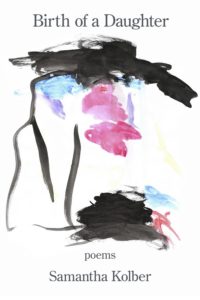Samantha Kolber’s 2020 chapbook of poems, Birth of a Daughter, is a celebration of love, pregnancy, birth, mothering, child-rearing, and the spiritual—at times visceral—bond between mother and daughter. Kolber frequently interrogates the social realities of being a mother and raising a young daughter, navigating the dangers and uncertainties of the twenty-first century. However, many of these poems are introspective, occupying a private space in which Kolber’s speaker-mother spends an untold number of hours, painfully and intimately attending her daughter’s needs amid interrupted nights and sleepy early mornings. Above all, the collection is funny, timeless, and frequently surprising in its frankness and subtlety, following the traditions of Rukeyser and Lorde, among other poets who celebrate and cast a vital, unsparing light on motherhood.
One of the most ingenious aspects of this slim volume of 17 poems is how deftly Kolber weaves between uncertainty and assurance, between fear and absolute hope. Kolber’s speaker-mother intones with soothing yet commanding imperatives in the opening psalm of the collection, “Cradle the Mother”:
feel the heartbeat
inside heart beat
feel the hand
making its own music
inside the cradle
plates shifting
not forming mountains
but humans
a girl this time
a mother for herself
We begin with a poem that is ageless, dense, and light, recalling the mysterious, private, and highly specific lyric of Jean Valentine. Here, Kolber makes full use of this slender lyric’s power: the duality of the couplets, the chant-like repetition of words, and the limiting of vocabulary to the point of compacting meaning and expanding the possibilities of each line. There is the heart beat within the heart’s beat; there is the hand inside the womb; and the body, a cradle for creation. Kolber’s speaker-mother hums through consonant ns and ms with an earthy, lullaby-drone. And that final line, “a mother for herself,” whose strange syntax alludes to a theme common in this collection—claiming one’s experience, recognizing the preciousness of the self, as Kolber’s speaker-mother later states in the eponymous poem, “Birth of a Daughter”: “It has only taken me 42 years to realize / I am precious, too.”
While the collection begins with an imperative (re: psalms that retain a sense of clarity, order, and hope amid the chaos of transformation), the tone quickly progresses/regresses toward a loss of control as the speaker-mother notes in “What Nourishes Me: Poem at Ten Weeks Pregnant” a litany of routines, foods, and sacrifices in the first months of pregnancy. Here, she is frank, casual, and unsparing, “My pregnancy app / tells me only 205 / days to go. Great.” The shift in tone is jarring compared to what came before, as Kolber’s speaker-mother laments how comfort foods, vitamins, and even “The smell / of food cooking” floods her with nausea. What high-minded illusions we might have about pregnancy and childbirth that the opening psalm suggests are immediately dashed by the reality of growing a person, which turns the body against oneself with unbearable cravings, bloating, constipation. The speaker-mother, however, revels in the feeling of her husband (and his body), whose very presence is “what nourishes” her with safety and arousal: “his skin touching mine, / filling in / the little voids / of my porous self.”
The poems that follow progress the reader through the speaker-mother’s stages of pregnancy, such as the poem “I Am Marked,” in which her body’s visible changes bring her into the unremitting crisis of being a woman, a soon-to-be-second-time mother, in a misogynistic society. She must endure the social objectification of pregnancy as well as the fetishized sacrifices and sanctity of motherhood. She is “marked” like a moving target in the twenty-first century by the fact of her sex as well as the physical transformation of her pregnancy, preventing her from hiding from the white male gaze.
The poem holds duality firmly, a frequent theme and visual marker that threads this collection (achieved most notably in couplets and in the visually arresting structure of “Breastfeeding Dyad”). While the speaker-mother must contend with the social reality, the painful, personal reality of these physical changes stages a deception, the body’s mutiny (to borrow a term from Lucia Perillo):
… I am branded
by my sex, which reproduces for you, …
And for me, my body deceives me. Stretches
and aches and jabs at me. My own expanding flesh
leers at me, a hinky afterthought, like the afterbirth
that will tug its way out after the wanted thing.
Here, the speaker-mother names the child as a “thing”—to “offer to the spoils / of this world, evil as the emerald politics / of an angry man”—while the speaker’s body is rendered as repulsive and vulnerable as the afterbirth. Again, this is a jarring tonal shift just as the form of the poem, with its wavelike meter enforcing the power of its voice, stands in contrast to the poems succeeding it, including the tense, 4–5 syllable staccato notations of “False Labor at 26 Weeks” and the fragmented, spacious “The Missing Poem: Birth,” whose first lines stop the breath:
urgent :
you arrived
seven pounds,
thirteen and a half ounces
unfed
The startling (premeditated, careful) explosion of words across the page again jars the reader into a new consciousness.
The collection climaxes, hitting its halfway point with the eponymous “Birth of a Daughter,” a poem patterned in couplets, reminiscent of “Cradle the Mother.” Time has progressed from the beginning of the collection; suddenly, we are launched three years after the birth of the speaker-mother’s daughter to a moment of recognition and clarity: “I birth myself anew / as I birth you, daughter.” The speaker-mother writes, away from her daughter, at last enjoying time to herself while her daughter is at “school”: “I work, I write, I sit outside / in the sun, and I can’t lie: it’s delicious, // this time away from you; it’s precious, as are you.”
The relationship between mother and daughter has evolved, no longer bound in the realm of the possible; the daughter is a breathing, moving (at times, blessedly “feral”; see: “What Feral Means to a Writing Mom”) person with her own personality, desires, and habits. And the weight of this collection pivots precisely at this point; daughter, as I (a male) hazard to interpret, is a mirror, slanted towards mother, sharing cells, sharing faces. This lineage, unbound by time or history, is reminiscent of the disorienting syntax of “Cradle the Mother”: “a girl this time / a mother for herself.” But as the speaker declares her own preciousness, she declares, thereby maintaining and managing, her own identity—an identity that exists prior to her daughter’s birth and continues to exist separate from this birth. She is a beloved person, as is her beloved daughter.
Following the midway point, the collection shifts toward longer, denser prose poems, embracing the hybridity of the form, including “My Toddler’s Scrambled Eggs” (recalling the foods of “What Nourishes Me”), “Heart Healthy,” “Write Like a Fighter,” and “7-Minute Fairytale.”
These poems detail the experience of raising a toddler through an age of threat and uncertainty as the dark “7-Minute Fairytale” reminds us, “Oh my, three years old and how can I protect her from the horrors of the world from the trafficking and the cages and the gang rape frat boys in college, will she even make it that far.” The poems also detail the experience of witnessing a toddler discover language, like in “Write Like a Fighter” when the daughter declares “‘All done,’ she says, and it’s the first time she says it correctly, pronouncing each letter, even the ‘n’ in ‘done.’”—and witnessing a toddler discover the joys of combining eating with play, as in “My Toddler’s Scrambled Eggs”: “Let’s be honest, usually I don’t eat; I watch her. And maybe eat her leftovers.”
The tonal shifts in the second half are less jarring as the prose form (and the sense of narrative built through its familiar composition) suggest a visual expansion and continuity. The rapid changes of form, tone, fragmentation, and appearance—all mirroring the trials of pregnancy, labor, and infancy—have given way to stability, even as the daughter becomes more and more of her own person (a source of miraculous joy and welcome silliness—“‘More. Nut,’ my daughter demands” from the poem “Heart Healthy”). Yet this visible expansion, owing to the form of the prose poem, is punctuated by more couplet-based poems, including the harrowing “The Girl Is Three” and the intimate “How to Celebrate a Dead Mom’s Birthday.”
Kolber ends the collection with another couplet-based psalm, a slanting mirror of the first, entitled “To My Daughter Sleeping Soundly in the Middle of the Night”:
You are the reason the world
keeps turning,
the reason people like me
do anything at all.
You are the reason we want
no wars.
You are the one perfect existence
to an imperfect earth.
One touch of your cheek
makes angels cry.
Kolber’s psalms bookend this collection, suggesting closure both thematically and structurally. The simplicity of the first psalm is repeated in this second; only this time, there is a sense of release, breath, and intimate hope. The first line of each staggered couplet presents a premise, “You are the reason we want…” “You are the one perfect existence…” By identifying her daughter, entrusting the future to her, the speaker-mother replicates the same process of naming she undergoes in poems such as “I Am Marked” and “Birth of a Daughter” (re: “I am precious”). And the second line of each staggered couplet invokes an ideal, sealing the open wounds of this troubled earth. The certainty of the speaker-mother’s voice dispels any cynicism or fatalism that threatens to harden her own heart.
As mentioned above, this act of declaring one’s identity, one’s preciousness, is a form of maintenance and management, a means of planting one’s feet on the ground, and standing up despite the bitterness of the modern era and the real dangers of living in this modern world. Birth of a Daughter, despite its short length, is deep and brimming with hope, complexity, craft, and, above all, love. Kolber leaves her reader with the sense of standing all, gazing upwards and outwards at the world our children will build.

Samantha Kolber has received a Ruth Stone Poetry Prize and a Vermont Poetry Society prize, and her manuscript “Jewel Tones” was a semifinalist with the Crab Orchard Series in Poetry’s 2019 First Book Prize. Her poems have appeared or are forthcoming in Oddball Magazine, Mom Egg Review, Poems2Go, Tiny Seed Journal, Rise Up Review, Hummingbird, Hunger Mountain, Minerva Rising, The Meadow, and other journals and anthologies. Her poem “Year in Review Haiku” was featured on Vermont Public Radio’s Vermont Edition in 2019. She received her MFA from Goddard College and completed post-grad studies at Pine Manor College’s Solstice MFA Program. Originally from New Jersey, she lives in Montpelier, Vermont, where she coordinates author events at Bear Pond Books and is the Poetry Series Editor at Rootstock Publishing. “Birth of a Daughter,” published by Kelsay Books (9/1/2020) is her first chapbook.

Birth of a Daughter by Samantha Kolber
Publisher: Kelsay Books
Paperback, 42 pages